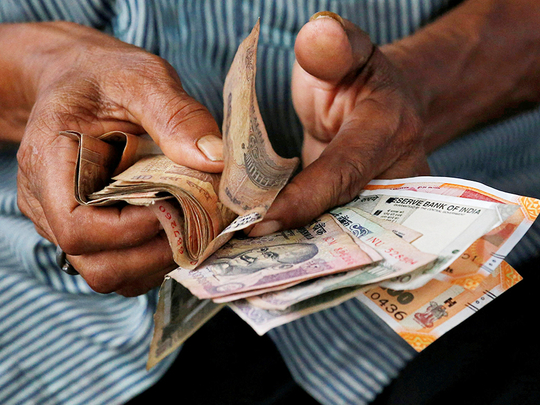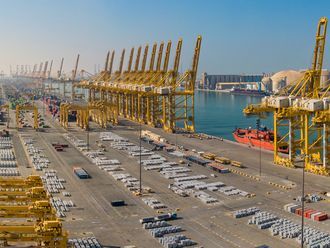
Mumbai: The rupee slumped by 30 paise to finish at a fresh lifetime low of 74.06 against the US dollar Monday amid strengthening of the greenback and steady capital outflows.
The rupee had opened lower by 14 paisa against Friday's close of 73.76 in early trade as the US dollar strength against major global currencies weighed on the rupee sentiment.
At the Interbank Foreign Exchange (Forex) market, the local currency opened lower at 73.89 a dollar against its previous closing of 73.76.
It recovered to a high of 73.76, but failed to sustain the momentum and plunged to 74.10 and finally closed at 74.06, down by 30 paise, marking its fifth straight session of decline.
On Friday, the domestic unit plummeted by 18 paise to end at 73.76.
Record-low rupee doesn’t scare India as global headwinds build
Mumbai: India’s central bank stared down the rupee’s slide to a record low, opting to keep interest rates unchanged as it flagged risks to the economy from global monetary policy tightening, trade wars and surging oil prices.
In a surprise decision, the monetary policy committee led by Governor Urjit Patel voted 5-1 to leave the repurchase rate at 6.5 per cent on Friday. The decision, which was predicted by just nine of 49 economists in a Bloomberg survey, sparked a sell-off in the nation’s currency and stocks.
The Reserve Bank of India’s pause after two hikes since June is in sharp contrast to its peers in Indonesia and the Philippines, who have pressed ahead with aggressive policy action to counter an emerging-market sell-off triggered by higher US rates and a stronger dollar. But in a clear indication that it’s not done with rate increases, the RBI changed its policy stance to “calibrated tightening” from the neutral that’s been in place since February 2017.
While the change doesn’t mean that every meeting will result in a rate hike, it does take rate cuts off the table, Governor Patel said. Lowering the inflation forecast to a range of 3.9 per cent to 4.5 per cent for the second half of the year ending March, from 4.8 per cent previously, allows the MPC room to pause on rates, he said.
Inflation for now is well below the 4-percent midpoint of the central bank’s target range, even as the economy expands at a world-beating 8 per cent plus pace.
“There are already forces at play that we expect will slow activity in coming quarters, including tighter financial conditions, higher oil prices and weaker global growth,” said Sonal Varma, chief India economist at Nomura Holdings Inc. and one of the nine economists who had forecast rates to remain unchanged. “Against this backdrop, the impact of cost-push factors should be limited and transient and, as the output gap again turns negative, underlying inflation should converge back towards 4.5 per cent.”
Undershooting
While headline inflation has eased in recent months, the core measure, which strips out volatile fuel, food and electricity prices, has been sticky at around 6 per cent.
The decision by the RBI comes at a time when liquidity conditions have tightened and there are worries that defaults by a systemically-important financier could lead to a contagion. Authorities have moved to ringfence Infrastructure Leasing & Financial Services Ltd., while the RBI has pledged to inject $5 billion into the system through bond purchases as it tries to ease the liquidity squeeze.
Foreigners have pulled $9.7 billion from local shares and debt this year, adding to worries that India will struggle to bridge its swelling current-account deficit. The government has raised import tariffs while the central bank allowed companies to raise more money abroad, though those efforts haven’t stopped the rupee’s slide.
On Thursday, the government lowered duties on fuel, providing some relief to consumers while putting pressure on its budget goals.
Unfazed
Patel appeared unfazed by the sharp drop in the currency, saying the depreciation was helping to correct external imbalances. The RBI doesn’t have any target or band in mind and acts only to manage volatility.
“The unchanged decision suggests that the Reserve Bank of India is not overly concerned about rupee depreciation,” said Mitul Kotecha, a senior emerging-markets strategist at TD Securities in Singapore.
The rupee, which is the worst performing major currency is Asia, has dropped about 7 per cent since August when the RBI last raised rates. At the same time, prices of crude oil — India’s biggest import — rose more than 10 per cent, a factor that is likely to drive headline inflation in coming months.
An increase in the price of oil to $96 a barrel could stoke inflation by 40 basis points above its estimate and damp growth by 30 basis points, the central bank said. Trading giant Mercuria Energy Group Ltd. said last month Brent may spike over $100 in the fourth quarter, amid concerns sanctions on Iran will shrink global supplies and as Venezuela’s industry continues to struggle.
The RBI lowered India’s economic growth projection for the first quarter of fiscal year 2020 to 7.4 per cent from the August projection of 7.5 per cent, while retaining the current year’s forecast at 7.4 per cent.












